Google Ads Performance Max Campaigns – Welcome to the Black Box
Written by: Gabriel Solberg Read time 10 minutes
Google Ads Performance Max campaigns first launched to all advertisers late last year. Performance Max is a campaign type where marketers relinquish most of their control and are forced to trust Google’s machine learning capabilities for better or worse.
This comes as no surprise given the direction of automation and the maturing of algorithms in ad tech. Some digital marketers embrace it others shudder at the thought of losing all control.
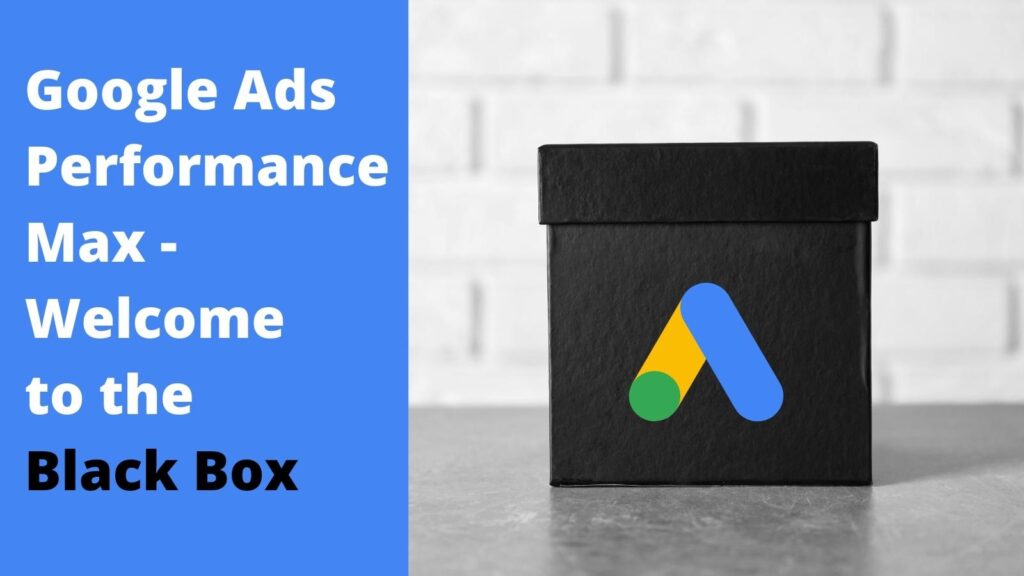
Performance Max Campaigns also called Pmax, since we love and need another marketing acronym, is essentially a Google Black Box. You can feed it assets, audience signals, and conversion data but performance reporting, at this point, is limited and you can only measure conversion results on the campaign level.
In this post, I’ll walk through the essential elements that constitute Google Ads Performance Max campaigns and what I have seen work and not work so far.
What is a Google Ads Performance Max Campaign?
Google Ads Performance Max is a new smart campaign type that leverages automation to improve campaign results. According to Google Pmax campaigns does not replace but complements search campaigns:
Performance Max campaigns as a new way to buy Google ads across YouTube, Display, Search, Discover, Gmail and Maps from a single campaign. They complement your keyword-based Search campaigns to help you grow performance across Google’s full range of advertising channels and inventory.
You essentially feed the campaign audience signals such as a customer list, set TCPA or ROAS bidding targets, and upload assets which include images, video, and text. Google will then leverage automation across its advertising ecosystem to find the people who are most likely to convert.
Where does Performance Max Serve?
Performance Max campaigns serve across all of Google’s ad channels and inventory. This means that your ads can show across YouTube, Display, Search, Discover, Gmail, and Maps. Rather than marketers identifying purchase or conversion intent based on upfront data, such as keyword intent, marketers lean on the algorithm to identify purchase or conversion intent regardless of where in Google’s ecosystem people are at a particular time.
The benefit of Performance Max Campaigns is that you are not locked into a low-quality network such as Display. Discovery campaigns somewhat improved the questionable display-only inventory for scaleable ads but Performance Max is leaning on all of Google’s ad inventory focused on using people’s intent signals to optimize for conversions. Sounds similar to Facebook’s methodology, doesn’t it?
How do you optimize Google Ads Performance Max Campaigns?
Outside of the landing page experience you only really have three leverage points to optimize Performance Max campaigns. Audience signals, creative and conversions.
Audience signals – I think of audience signals as seed audiences. A targeting approach we are familiar with when building Lookalike audiences on Facebook. The higher the quality of the seed audience the better the Lookalike audience performs.
Creative – Creative, images, video, and text aligned with your target persona are critical to ensuring that it hooks the right people and gets ignored by people you do not want to target.
Conversions – Quality high-intent conversion signals are important so Google Ads can identify similar people likely to convert. For e-commerce, the focus conversion is pretty straightforward given that it is typically a purchase. For lead generation efforts this can be trickier since you ideally want to only optimize for qualified leads which tends to include a down funnel signal.
Welcome to the Performance Max Black Box
At this time conversion max campaigns or somewhat of a Google black box. You give them signals and assets but really have no idea where these are going to get served. In addition, you can’t report on what asset, asset combination, or placement performed best. So it really comes down to trusting Google Ads to use defined audience signals and conversion data. However, there are some settings you can control to steer Pmax campaigns in the direction of success. Let’s review each one of these settings next.
Add Value Rules but Don’t Ask for Insights
Value rules are defined on the campaign level. Value rules are not new and you can use them for other campaign types such as search campaigns. I like the idea of value rules but again Google does not give you any insights into how value rules are improving performance. For performance max campaigns you can set value rules for audiences, devices, or locations.

For example, I use value rules for B2B lead generation search campaigns. Adding multipliers for the Google Ads B2B employer size audience should in theory increase the value of people coming from bigger businesses. Although without performance insights the directional measurement of lead quality in your CRM is hard to do.
Regardless of the measurement limitations, I would still add value rules on the campaign level. Not all audiences are available for value rules. At this point, you are limited to website visitors, YouTube users, or Customer Lists.
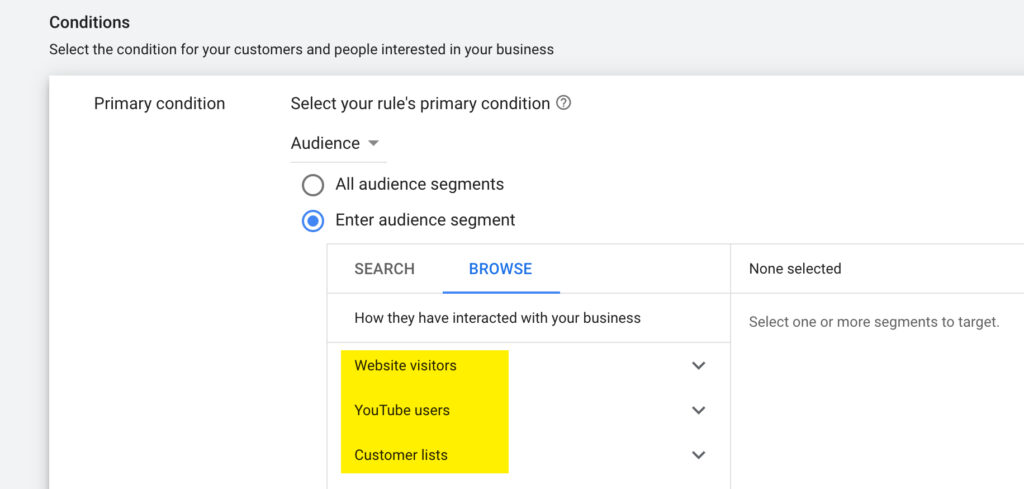
Final URL Expansion or Landing Page Control?
You can choose to let Google use additional URLs to send people to. This Performance Max feature is similar to Dynamic Search Ads. Enabling Final URL Expansion comes down to how much control you want to give Google. It also comes down to how restricted you are in regards to legal and compliance. However, if you do enable this setting Google does allow you to define URLs to exclude.
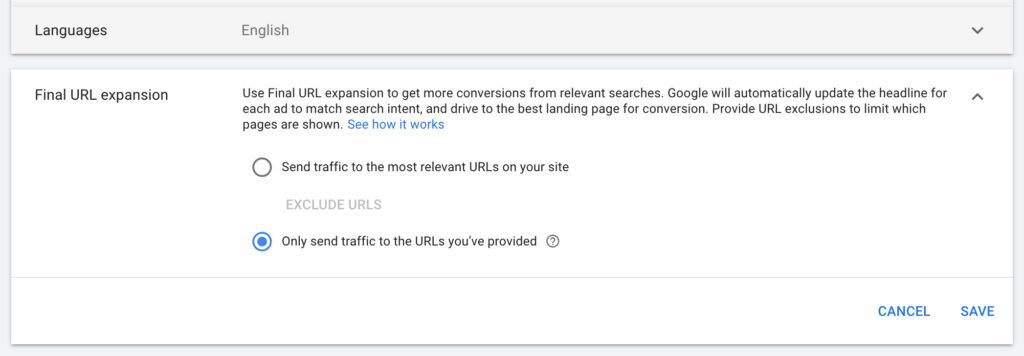
Personally, I have not activated the Final URL Expansion setting in any of my Pmax campaigns and have seen pretty good results so far. In theory, if you are on board with giving Google Ads all control leaving this Send traffic to the most relevant URLs on your site would be the way to go. With reporting limitations the only way to really test the Final URL Expansions setting is to create two separate but identical campaigns one with the setting enabled and the other with the setting disabled.
Goodbye Ad Groups and Ads. Hello Asset Groups
Instead of Ad Groups and Ads, you now have asset groups. The name makes sense since this is where you throw together all of your creative assets including images, videos, and text. You can also add campaign or account level extensions to an asset group.
Google Ads does let you add multiple asset groups in one campaign. However, at this time you get no performance insights into which asset group is performing best. My recommendation would be to group copy, images, and video by target persona and only run one asset group per campaign.
This is what I have done so far so that I can measure persona-based creative and messaging performance which has worked. Although without being able to exclude audiences I am cannot say how this impacts delivery and performance in regards to audience overlap.
Perfomance Max Search Copy
A quick note on search copy. To me, performance max campaigns are less about being pretty and more about inputting as many known conversion driving signals as possible. As a result, for search copy, I looked at historical data and pulled the best performing headlines and description lines across the account, and used these for ad copy. So far this seems to work. Again with limited insights, it’s hard to tell what asset elements are and are not working.
A Note on Video Assets
Adding video assets is not required when creating an asset group. However, I strongly caution against not adding video. If there are no videos in an asset group Google will create their own videos using copy and static images. The results can be interesting. For creative quality, at least at this point, you are better off making sure to add video assets.
Budget Minimums – Spend to Learn
You need to give Performance max campaigns a healthy budget so that Google can spend your money to learn. My general rule is to set the daily minimum to 4x your target CPA.
Spend behavior for Google Ads Performance Max campaigns is similar to what I have seen with display and discovery campaigns. Pmax campaigns can take 1-2 days before getting any real delivery then, they spend aggressively the first few days before normalizing daily spend amounts. I would recommend running new campaigns for at least 5 days before making any decisions.
If you do not have the budget to run a Google Ads Performance Max campaign for a minimum of 5 days with a 4x target CPA I would say stay away from Pmax campaigns. I am not sure why Google Ads has not figured out a way to stabilize delivery and spend amounts which Facebook Ads is pretty good at. My guess would be that the sheer volume of their inventory caters these campaign types to advertisers with bigger budgets.
Audience Signals – It’s a Lookalike World
I think of audience signals as the seed audience used to build Lookalikes on Facebook Ads. Earlier I wrote a post about the similarities between Search Broad Match and Facebook Ads Lookalike targeting. Google Ads Performance Max follows the same concept but on steroids.
For new campaigns, Google recommends using two audience signals. One custom segment and one customer data audience.
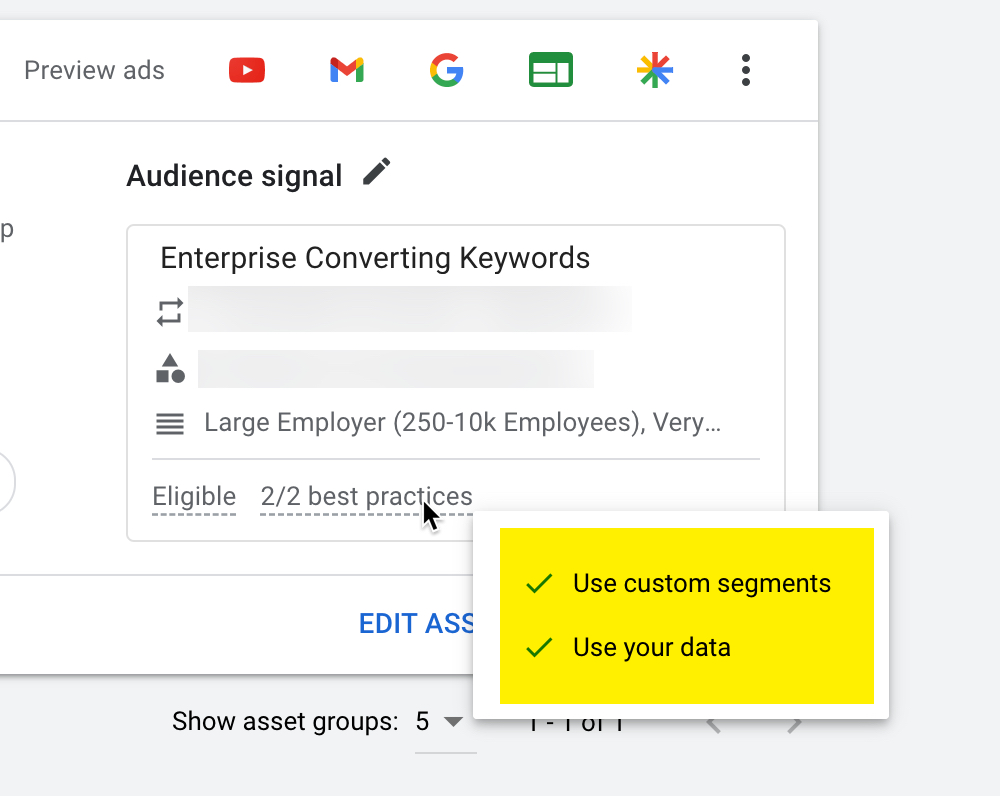
To test into Performance Max campaigns I did the following:
Custom Segments
For Custom Segments I pulled all keywords, not search terms, with conversions over the last 30 days in the ad account. I then filtered down to keywords with a minimum of three conversions. In addition, I only included keywords with a break-even or positive ROAS. For lead generation campaigns I only included keywords where the cost per conversion was within 20% of an acceptable CPA. Doing this gave me a strong keyword seed list for a custom segment audience based on people’s search activity.
Custom Data
Similar to Facebook I want Google to optimize for my key conversion action which is a purchase or qualified lead. I am less concerned about the audience size for this segment. Rather, my focus is on making this list as qualified as possible.
Things to Watch out For With Google Ads Performance Max Campaigns
There are a few things to watch out for when you start testing Performance Max campaigns. Some of these you can consider drawbacks and others come with the territory of giving up control and letting the machines take over.
Search Cannibalization
It is not clear how Google sets the priority of Performance Max campaigns over search campaigns. Google does say Pmax campaigns complement your keyword-based search campaigns. However, given that Performance Max campaigns do serve on search there is a good chance that it will eat into your search campaigns, including brand campaigns. When launching PMax campaigns monitor delivery and performance of brand and non-brand search campaigns to understand the impact.
I mean if Pmax campaigns drive conversions more efficiently than search campaigns it is not necessarily a bad thing but it does take away the control you have on how to position your brand and or product, especially for Brand campaigns.
Lack of Reporting Insights
You don’t get a whole lot of actionable reporting insights lower than the campaign level. This is why I created one campaign for each persona tailored creative set so that I can measure results for creative input.
On the asset group level, you have a rating of individual assets that range from Poor to Excellent similar to responsive search ads. You can also view your top asset combinations. However, you do not get any additional insights outside of letting you know your top combinations.

You can get some insights into search terms and audiences your ads have shown for under the insights tab. Insights won’t show immediately and can take some time before they are displayed. In addition, not all campaigns will show audience and search term insights.
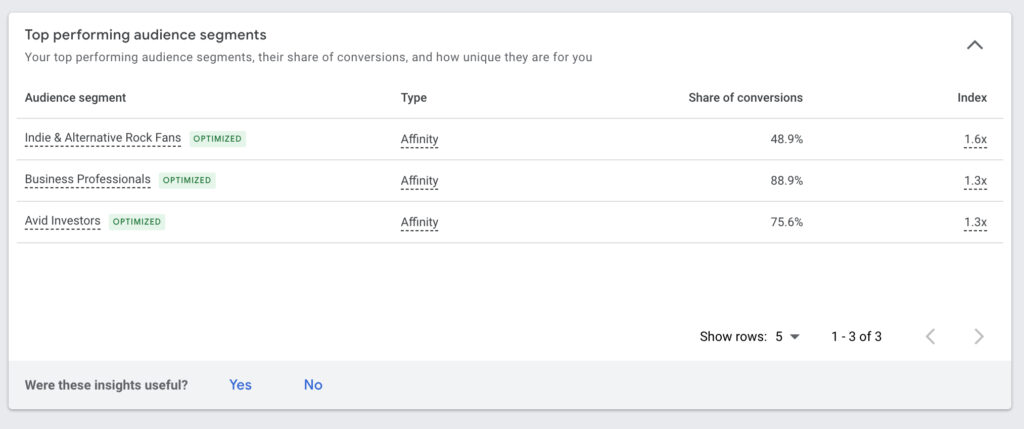
Can’t Add Negative Keywords
To protect brand searches and other high intent lower funnel search campaigns it would be great if we could add negative keywords to Pmax campaigns. However, for now, you cannot. There are rumors that you will be able to add negative keywords on the account level but that has not materialized yet.
Monitor Lead Quality
I have run Pmax campaigns predominantly for B2B leads running on a TCPA bidding model. The conversion was optimized for strictly leads and even though the lead quality was better than working with responsive display or discovery campaigns, I have not seen a significant indicator that Pmax campaigns drive a larger number of high-quality leads. For lead gen, I think the biggest lever is to optimize for a down funnel metric if you can. This will give Google Ads stronger signals of what type of people to look for in their ecosystem.
What’s the Verdict with Google Ads Performance Max Campaigns
The verdict is still out whether Google Ads Performance Max campaigns are superior and will take over other campaign types. They are definitely not going anywhere and Google is pushing on advertisers to start using these.
When testing Performance Max on lead gen accounts I saw a 40% lower cost per lead and a ton scale potential. I was able to quickly scale campaigns to $4k – $5K per day without seeing a drop in performance. I have only been able to replicate quick scaling like this on Facebook Ads. Given the buying cycle lead quality is still to be determined.
As a side note, you can (and should when possible) integrate Google Ads with your CRM to send down funnel conversions and qualified leads back to Google Ads to create a quality conversion feedback loop. Similar to how you can send Salesforce events back to Facebook through their conversion API Google Ads offers a native Salesforce integration.
Conclusion
We have known for a while that Google Ads was going in the direction of less manual controls and handing things over to their algorithm. Discovery campaigns and the improved performance of TCPA bidding in conjunction with Broad match campaigns were another sign. Google is also saying that Smart Shopping and Local campaigns will be upgraded to Performance Max campaigns at some point this year.
It makes sense for Google to leverage their massive inventory and first-party data signals to build a scaleable advertising solution. By including search and YouTube inventory they can now offer display type reach without the display type results.
Google Ads Performance Max shows a lot of promise to run scaleable audience-based campaigns. The key is to have persona-tailored creative assets and solid conversion signals to send back to the ad platform.
What has your experience been working with Google Ads Performance Max campaigns?
AUTHOR BIO:

With over a decade of digital marketing experience, Gabriel excels in search, display, and social advertising across various industries. He specializes in performance media and data-driven storytelling, building custom digital ecosystems that enhance user experiences across both paid and owned channels. Connect with Gabriel on LinkedIn or explore more of his articles here.
Leave a comment